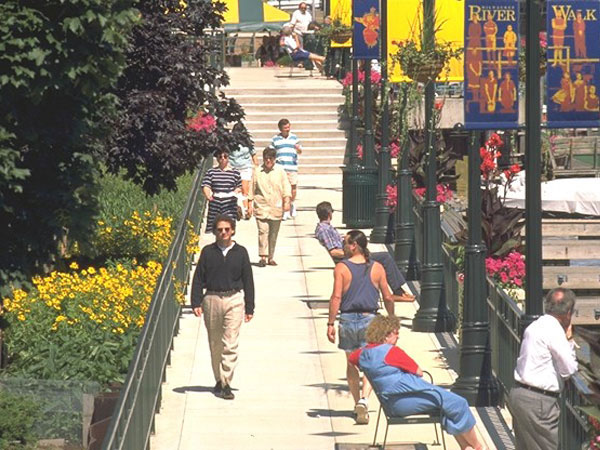Milwaukee RiverWalk: Milwaukee, Wisconsin

Summary
Milwaukee RiverWalk was planned as a down-to-earth public space where residents could take peaceful walks, dine outdoors, and access the river for fishing, kayaking, and canoeing. It has been more successful than anyone involved with the unique public-private initiative ever imagined. Construction of the $35 million pedestrian-only walkway, which has one of the most innovative bridges found anywhere, increased the value of adjoining property by more than $500 million. Removal of a dam at the northern end of the walkway, a cleanup of river pollution, and wastewater treatment improvements have enhanced water quality and helped restore fisheries to the river.
Designated Area
RiverWalk extends along both sides of the Milwaukee River from the harbor in the Third Ward District north through downtown to the former North Avenue Dam.

The walkway is adorned with plants, many of them indigenous to the area. Businesses are responsible for maintaining and planting their sections. Photo courtesy of the Department of City Development.
Planning Excellence
Initiated by former mayor John O. Norquist in 1988, the planning and development of Milwaukee RiverWalk involved a partnership between the city and property and business owners along the river. Gary Grunau led the business community's support, which was essential because public access along the walkway is granted through easements.
Residents, including children, played an important role in helping plan and design RiverWalk. More than 200 students explored the Milwaukee River and made drawings of what they discovered. The result was 18 pieces of artwork being selected and cast in bronze medallions located throughout the length of the Riverwalk.
Other public art includes the "Bronz Fonz," a statue of Henry Winkler who starred as Fonzie in Happy Days, the popular television sitcom set in 1950s-60s Milwaukee.
The pride residents have for the RiverWalk and everything it has done to improve downtown and adjoining neighborhoods is unmistakable. RiverWalk designer and landscape architect Ken Key has an explanation: "The more you can do to make people feel that this is about connections, the better."

The RiverWalk is thronged with pedestrians taking advantage of a cleaner river and fresh air. The walk is open only to pedestrians, however, it will be 100 percent ADA compliant within the next year. Photo courtesy of the Department of City Development.
Defining Characteristics, Features
Extensive planning, mayoral leadership
- Discovery of 1904 sketch of downtown esplanade by architect Alfred C. Clas, combined with former Mayor John Norquist's inspiration from San Antonio's river walk, leads to plan and design for Milwaukee RiverWalk
- RiverWalk Initiative launched, design guidelines created, and overlay district adopted 1988-1993; 3.1-mile walkway constructed between 1994-1997
- Hydraulic operated center-lift (to 24 feet) pedestrian bridge built at Highland Avenue; only bridge of its kind in U.S.; 16 feet wide, cost $2.8 million
- North Avenue dam removed as part of RiverWalk initiative
Public-private partnership
- Goal of RiverWalk is to increase public access and stimulate commerce; property owners and city form Business Improvement Districts (BID) to manage construction and maintenance of RiverWalk
- City uses state's Public Trust Doctrine (1787 and 1972), which places all lakes and streams in Wisconsin for the benefit and use of all citizens, as legal basis to establish RiverWalk; RiverWalk Development Fund, RiverWalk Site Plan, and Overlay District comply with doctrine
- Tax incremental districts (TID) formed to leverage private development investment; tax increment financing also used to fund environmental cleanup and public improvements along river
- Funded through public-private partnership involving $25 million from city and $10 million from property owners; city contributed up to 70 percent of the cost to construct walkway in exchange for public easements across private property
Innovative design, catalyst for city revitalization
- Uniform design in way finding design, signage, logos, public art features used to maintain look and identity of the RiverWalk
- Walkway links businesses, theaters, and neighborhoods and spurs development; RiverWalk contributes to $712 million increase in commercial and residential investments — more than 50 percent growth from 1998 to 2002
- Milwaukee RiverWalk District's 20th anniversary was September 2011; walkway receives multiple design awards, recognition
- $4.7 million worth of modifications underway to ensure RiverWalk to be 100 percent compliant with ADA standards by 2012

Located along the walk in downtown is Pere Marquette Park, the site of concerts and festivals. Lush grass, shady trees, and a gazebo are a natural draw for visitors to rest and enjoy the view. Photo courtesy of the Department of City Development.


